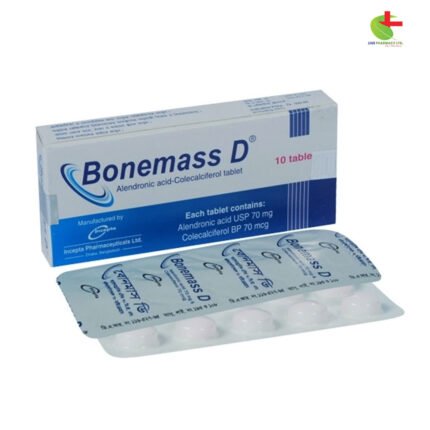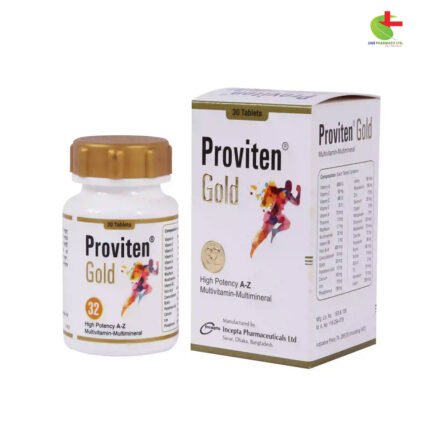Pulmosis 267
450.00৳ Strip(10)
- Pulmosis is indicated for the treatment of mild to moderate Idiopathic Pulmonary Fibrosis (IPF) in adults.
- It contains Pirfenidone, a novel agent with anti-inflammatory, antioxidant, and anti-fibrotic properties.
- Pulmosis helps improve lung function and reduces acute exacerbations in IPF patients.
- It is taken orally with food, with a titration dosing regimen over the first 14 days to reach a recommended dose of 2403 mg/day.
 Brand
Brand
|
Incepta Pharmaceuticals Ltd |
|---|---|
 Generics
Generics
|
Pirfenidone |
 Type
Type
|
Tablet |
Indications
Pulmosis is prescribed for adults to manage mild to moderate Idiopathic Pulmonary Fibrosis (IPF). Always follow the guidance of a registered healthcare professional when using this medication.
Consult a registered healthcare provider before taking this medicine.
Pharmacology
Pirfenidone, the active ingredient in Pulmosis, is a groundbreaking drug with anti-inflammatory, antioxidant, and anti-fibrotic effects. It may help improve lung function and decrease acute exacerbations in individuals suffering from IPF. While the precise molecular action of pirfenidone is still being studied, it is known to suppress TGF-β1 (transforming growth factor-β1), a critical factor in fibrosis development. Additionally, pirfenidone has been shown to reduce the expression of key inflammatory cytokines, including TNF-α, interleukin-1, and interferon-gamma. Animal studies suggest that pirfenidone can decrease inflammatory cell infiltration and reduce pulmonary vascular permeability induced by bleomycin.
Dosage and Administration
Route of Administration: Pulmosis should be taken orally with food.
For Adults: Start treatment by gradually increasing the dose to the recommended level over 14 days:
- Days 1-7: Take one 267 mg tablet three times a day (801 mg/day)
- Days 8-14: Take two 267 mg tablets three times a day (1602 mg/day)
- From Day 15 onward: Take three 267 mg tablets or one 801 mg tablet three times a day (2403 mg/day)
The standard recommended dose for IPF patients is three 267 mg tablets or one 801 mg tablet three times daily with food, totaling 2403 mg per day. Doses exceeding 2403 mg per day are not advised. If treatment is missed for 14 or more consecutive days, patients should restart with the initial 14-day titration. For shorter interruptions, resume the previous dose without titration.
Important Dose Adjustments:
- Gastrointestinal issues: If patients experience gastrointestinal side effects, taking Pulmosis with food may help. If discomfort persists, reduce the dose to 1-2 tablets (267-534 mg) 2-3 times a day with food, then gradually increase to the recommended dose as tolerated. If symptoms continue, consider a 1-2 week treatment pause.
- Photosensitivity or rash: For mild to moderate photosensitivity or rash, recommend sunscreen use and avoid sun exposure. Reduce the dose to three 267 mg tablets per day. If the rash persists after 7 days, temporarily discontinue treatment for up to 15 days and then resume gradually. Severe reactions require stopping the drug and consulting a healthcare professional.
- Liver function: If liver enzyme levels (ALT/AST) significantly rise, adjust or stop treatment based on guidelines.
Drug Interactions
- Medicines: Strong or moderate inhibitors of CYP1A2 (e.g., fluvoxamine, ciprofloxacin) can increase Pulmosis’ effects. Discontinue fluvoxamine before starting Pulmosis or adjust the dose to 267 mg three times daily. Consider dosage adjustments with ciprofloxacin.
- Food and others: No significant interactions with food. Studies show a lower incidence of side effects when taken with food.
Contraindications
- Allergic reactions to pirfenidone or any excipients
- Concomitant use of fluvoxamine
- Severe liver or kidney disease (e.g., CrCl <30 ml/min or end-stage renal disease)
- Pregnancy and lactation: Pulmosis should only be used if the potential benefits outweigh the risks. Consult a healthcare professional.
Side Effects
Common: Nausea, rash, abdominal pain, upper respiratory infections, diarrhea, fatigue, headache, dyspepsia, dizziness, vomiting, anorexia, gastroesophageal reflux disease (GERD), sinusitis, insomnia, weight loss, arthralgia.
Rare: Photosensitivity, decreased appetite, pruritus, asthenia, altered taste, non-cardiac chest pain.
Pregnancy & Lactation
- Pregnancy: There are no sufficient data for pregnant women. Animal studies show the drug can accumulate in amniotic fluid and may affect fetal viability at high doses. It is advised to avoid Pirfenidone during pregnancy.
- Lactation: It is unclear whether pirfenidone is excreted in breast milk. Given the potential risks to the infant, a decision must be made to either discontinue breastfeeding or stop Pirfenidone treatment, depending on the benefits for the mother and the child.
Fertility: Studies in rats show no adverse effects on fertility at doses up to 1000 mg/kg/day (three times the human maximum recommended dose).
Precautions & Warnings
- Liver Enzyme Monitoring: Monitor liver enzymes (ALT, AST, bilirubin) during treatment. Adjust the dose or discontinue if necessary.
- Photosensitivity and Rash: Avoid sun exposure and use sunscreen daily. Adjust the dose or temporarily stop the drug if required.
- Gastrointestinal Disorders: If side effects occur, dose adjustments or temporary discontinuation may be needed.
Special Population Use
- Children & Adolescents: The safety and efficacy of Pulmosis in individuals under 18 years have not been established.
- Hepatic Impairment: Caution is advised for those with liver issues. Dose adjustments may be necessary.
- Renal Impairment: Not recommended for patients with severe renal disease. Monitor closely for adverse reactions.
- Smokers: Smoking can decrease the effectiveness of Pulmosis due to lower systemic exposure.
Overdose Effects
There is limited clinical data on overdose. In studies, multiple doses up to 4806 mg/day (six 267 mg tablets three times daily) were administered over 12 days without severe effects. Any adverse reactions were mild and transient, consistent with common side effects of Pulmosis.
Therapeutic Class
Immunosuppressant
Storage Instructions
Store in a cool, dry place, away from light and moisture. Keep out of reach of children.













Reviews
There are no reviews yet.